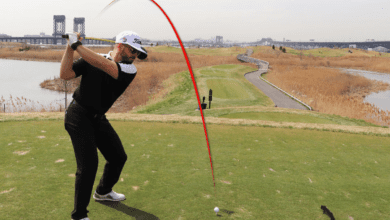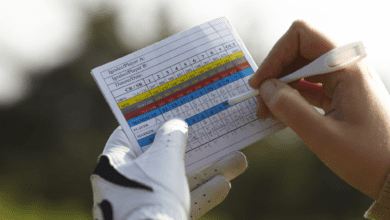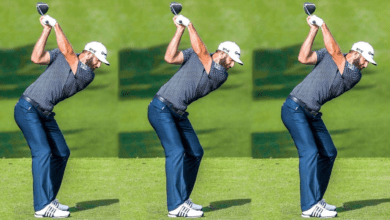How to Improve Your Golf Putting: Techniques for Consistency and Accuracy

Introduction:
1. Develop a Solid Setup- Improve Your Golf Putting
A proper setup is fundamental to a successful putting stroke. Ensure your feet are shoulder-width apart, your eyes are directly over the ball, and your arms hang naturally. Maintain a relaxed and balanced posture throughout the stroke.
2. Master Your Alignment- Improve Your Golf Putting
Aligning yourself correctly with the target is crucial for accurate putting. Use a target line or an intermediate target to guide your aim. Make sure your putter face is square to the target line at address.
3. Find the Right Grip
Experiment with different putting grips to find the one that suits you best. Popular options include the traditional overlapping grip, the cross-handed grip, and the claw grip. Choose a grip that provides you with stability and control.
4. Develop a Pendulum Motion- Improve Your Golf Putting
Developing a pendulum motion is a fundamental technique for improving your golf putting consistency and accuracy. It involves creating a smooth and rhythmic stroke that mimics the motion of a pendulum swinging back and forth. Here’s an explanation of how to develop a pendulum motion and why it’s important for your putting game:
- Proper Setup and Alignment: Start by setting up in a balanced and athletic position with your feet shoulder-width apart and your weight evenly distributed. Align your body parallel to the target line, ensuring that your eyes are directly over or slightly inside the ball. A proper setup establishes the foundation for a consistent and effective pendulum motion.
- Stable Lower Body: A key aspect of the pendulum motion is minimizing lower body movement. Keep your lower body stable and avoid unnecessary shifting or swaying during the stroke. This allows you to maintain a consistent pendulum-like motion with your arms and putter.
- Controlled Backswing: Begin the putting stroke by smoothly and controlledly swinging the putter back with your shoulders and arms. The backswing should be relatively short and controlled, allowing you to maintain control and precision. Avoid excessive wrist movement or jerky motions.
- Smooth Transition and Acceleration: As the putter reaches the end of the backswing, initiate a smooth transition into the forward swing. Maintain a constant tempo and gradually accelerate the putter through impact and into the follow-through. This ensures a consistent and fluid pendulum-like motion.
- Square Putter Face: Throughout the pendulum motion, it’s crucial to keep the putter face square to the target line. This helps promote a straight and accurate roll of the ball. Pay attention to your grip pressure to avoid twisting or opening the putter face during the stroke.
- Minimal Manipulation: One of the benefits of the pendulum motion is that it minimizes hand and wrist manipulation. Instead, the stroke relies on the larger muscles of the shoulders and arms, providing better stability and consistency. Avoid excessive hand or wrist movement that can introduce inconsistency into your stroke.
- Practice and Repetition: Developing a reliable pendulum motion requires practice and repetition. Spend time on the putting green practicing short putts and gradually work your way to longer distances. Focus on maintaining the pendulum-like motion and feel the rhythm and tempo of the stroke.
5. Control Your Distance
Distance control is crucial for effective putting. Practice varying the length of your backswing to control the distance the ball travels. Develop a feel for the speed of the greens by practicing different-length putts.
6. Focus on the Sweet Spot
Consistently striking the sweet spot on your putter face is essential for accuracy. Spend time practicing your stroke and finding the center of the putter face consistently. This will help minimize off-center strikes and unwanted directional deviations.
- After the Loss of a Son, a Football Coach Confronts a Terrible Truth
- Colts release Kenyan Drake, Patriots waive 11 more players
- Mother of embattled Spanish soccer federation president launches hunger strike over kiss drama
- Dodgers’ Mookie Betts overtakes Ronald Acuna Jr., becomes NL MVP favorite
- Giants waive James Robinson, Eagles, Steelers announce spate of releases
7. Read the Greens
Take the time to read the slopes and breaks on the greens. Pay attention to the grain of the grass, slopes created by mowing patterns, and subtle undulations. Aim to visualize the path the ball will take and adjust your aim accordingly.
8. Practice Distance Control Drills
Practicing distance control drills is essential for improving your golf putting accuracy and consistency. Distance control refers to your ability to judge the distance between your ball and the hole and make the appropriate stroke to reach the desired distance. Here’s an explanation of why distance control drills are important and how they can benefit your putting game:
- Develop Feel and Touch: Distance control drills help you develop a better sense of feel and touch with your putter. By practicing different distances, you train your body to gauge the amount of force needed to roll the ball a specific distance. This helps you develop a more refined sense of touch, allowing you to control the speed and distance of your putts more accurately.
- Improve Consistency: Consistency is key in putting, and distance control drills can greatly enhance your ability to consistently roll the ball the desired distance. By repeatedly practicing putts from various distances, you train your body to consistently apply the right amount of force for each putt. This leads to more consistent results and reduces the likelihood of three-putting or leaving putts short.
- Enhance Putting Confidence: When you have confidence in your ability to control the distance of your putts, you approach each putt with a greater sense of assurance. Distance control drills build that confidence by allowing you to see improvements in your ability to judge and execute the proper distance. This increased confidence translates into more successful putts and better overall performance on the greens.
- Develop a Repertoire of Putting Strokes: Distance control drills encourage you to develop a range of putting strokes to accommodate different distances. For shorter putts, you may use a shorter backswing and a more controlled stroke, while longer putts may require a longer backswing and a smoother, flowing motion. By practicing various distances, you can refine different putting strokes and become more versatile on the greens.
- Prepare for Course Conditions: Distance control drills help you adapt to different green speeds and course conditions. Greens can vary in speed depending on factors such as weather, moisture levels, and maintenance. By regularly practicing distance control drills, you become better equipped to adjust your putting speed based on the specific conditions you encounter during rounds.
9. Develop a Pre-shot Routine
Establishing a pre-shot routine can help you maintain focus and consistency. Develop a sequence of actions, such as visualizing the putt, taking practice strokes, and aligning yourself with the target. Stick to this routine before every putt to enhance your mental and physical readiness.
10. Manage Pressure and Stay Calm
Managing pressure and staying calm are crucial aspects of improving your golf putting. When faced with a high-pressure situation, such as a crucial putt or a competition, it’s common for golfers to experience increased nerves and anxiety, which can negatively impact their performance.
To effectively manage pressure, it’s important to develop strategies that help you stay calm and focused. Here are some techniques to consider:
- Deep Breathing: Taking slow, deep breaths helps slow down your heart rate and relax your body. Incorporate deep breathing exercises into your pre-shot routine to help calm your nerves and maintain a sense of control.
- Positive Self-Talk: Replace negative thoughts and self-doubt with positive affirmations. Remind yourself of your abilities and previous successful putts. Building a positive mindset can boost your confidence and help you approach the putt with a more optimistic outlook.
- Visualization: Visualize successful putts before you step up to the ball. Picture the ball rolling smoothly along the intended line and dropping into the hole. Visualizing success helps build confidence and creates a mental image of the desired outcome.
- Focus on the Present: Instead of worrying about the outcome or past mistakes, focus on the present moment. Direct your attention to the task at hand, such as your alignment, stroke, and target. By staying fully present, you can better execute your putting technique and make more confident strokes.
- Establish a Pre-Shot Routine: Develop a consistent pre-shot routine that includes specific actions and rituals. This routine helps create a sense of familiarity and calmness, allowing you to maintain a focused mindset throughout the putting process.
- Practice Under Pressure: Simulate pressure situations during your practice sessions. Set up drills or challenges that require you to make important putts. By exposing yourself to pressure in a controlled environment, you can become more comfortable and better equipped to handle it during actual rounds.
Conclusion:
Improving your golf putting requires a combination of technical skills, mental focus, and dedicated practice. By implementing the techniques and tips outlined in this article, you can enhance your consistency and accuracy on the greens. Remember, putting is a skill that develops over time, so be patient and persistent in your practice. With dedication and a focus on these fundamental techniques, you’ll see improvements in your putting game and ultimately lower your scores on the golf course.
Also Read
How to Attend the Masters Tournament: Ticket Purchase and Planning Tips





